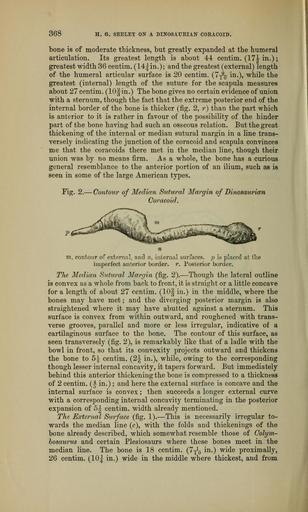MAKE A MEME
View Large Image

| View Original: | The_Quarterly_journal_of_the_Geological_Society_of_London_(13859917455).jpg (1245x2068) | |||
| Download: | Original | Medium | Small | Thumb |
| Courtesy of: | commons.wikimedia.org | More Like This | ||
| Keywords: The Quarterly journal of the Geological Society of London (13859917455).jpg 368 H G SEELET ON A DINOSAUEIAN CORACOID <br> bone is of moderate thickness but greatly expanded at the humeral <br> articulation Its greatest length is about 44 centim 17J- in ; <br> greatest width 36 centim 14 in ; and the greatest external length <br> of the humeral articular surface is 20 centim 7 T 9 - in while the <br> greatest internal length of the suture for the scapula measures <br> about 27 centim 10 Jin The bone gives no certain evidence of union <br> with a sternum though the fact that the extreme posterior end of the <br> internal border of the bone is thicker fig 2 r than the part which <br> is anterior to it is rather in favour of the possibility of the hinder <br> part of the bone having had such an osseous relation But the great <br> thickening of the internal or median sutural margin in a line trans- <br> versely indicating the junction of the coracoid and scapula convinces <br> me that the coracoids there met in the median line though their <br> union was by uo means firm As a whole the bone has a curious <br> general resemblance to the anterior portion of an ilium such as is <br> seen in some of the large American types <br> Fig 2 ” Contour of Median Sutural Margin of Dlnosaurian <br> Coracoid <br> n <br> 9H contour of external and n internal surfaces p is placed at the <br> imperfect anterior border r Posterior border <br> The Median Sutural Margin fig 2 ” Though the lateral outline <br> is convex as a whole from back to front it is straight or a little concave <br> for a length of about 27 centim 10J in in the middle where the <br> bones may have met ; and the diverging posterior margin is also <br> straightened where it may have abutted against a sternum This <br> surface is convex from within outward and roughened with trans- <br> verse grooves parallel and more or less irregular indicative of a <br> cartilaginous surface to the bone The contour of this surface as <br> seen transversely fig 2 is remarkably like that of a ladle with the <br> bowl in front so that its convexity projects outward and thickens <br> the bone to 5 centim 2-i- in while owing to the corresponding <br> though lesser internal concavity it tapers forward But immediately <br> behind this anterior thickening the bone is compressed to a thickness <br> of 2 centim A in ; and here the external surface is concave and the <br> internal surface is convex ; then succeeds a longer external curve <br> with a corresponding internal concavity terminating in the posterior <br> expansion of 5 centim width already mentioned <br> The External Surface fig 1 ” This is necessarily irregular to- <br> wards the median line c with the folds and thickenings of the <br> bone already described which somewhat resemble those of Colym- <br> bosaurus and certain Plesiosaurs where these bones meet in the <br> median line The bone is 18 centim 7 in wide proximally <br> 26 centim 10 in wide in the middle where thickest and from 36936169 113692 51125 Page 368 Text 38 http //www biodiversitylibrary org/page/36936169 1882 Geological Society of London Biodiversity Heritage Library The Quarterly journal of the Geological Society of London v 38 1882 Geology Periodicals Smithsonian Libraries bhl page 36936169 dc identifier http //biodiversitylibrary org/page/36936169 smithsonian libraries Information field Flickr posted date ISOdate 2014-04-15 Check categories 2015 August 26 CC-BY-2 0 BioDivLibrary https //flickr com/photos/61021753 N02/13859917455 2015-08-26 07 53 42 cc-by-2 0 PD-old-70-1923 The Quarterly journal of the Geological Society of London 1882 Photos uploaded from Flickr by Fæ using a script | ||||